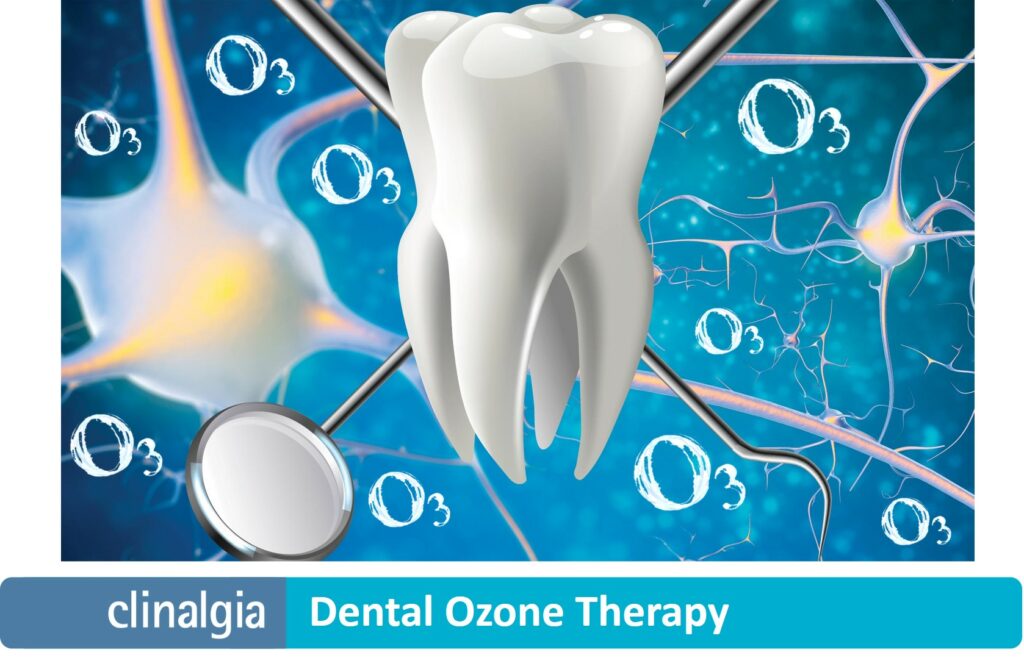
Dental Ozone Therapy

Dental ozone therapy is used for dental and oral treatments (herpes, aphthous ulcers, etc.) by destroying pathogenic germs.
Ozone, known for its microbial and disinfectant properties, is used in the medical and dental field avoiding the inflammatory process and promoting healing at the cellular level.
Ozone is a molecule of gaseous nature formed by three oxygen atoms (O3) instead of the two atoms of which the oxygen molecule (O2) is composed.
Ozone therapy consists of the application of medical ozone for therapeutic purposes.
In the case of its application in the dental field, we speak of dental ozone therapy or ozone therapy in dentistry.
Dental Ozone Therapy Index
What is Dental Ozone Therapy?
Applications of Dental Ozone Therapy
Ozone therapy in periodontal disease
Ozone therapy in fillings and adhesive restorations.
Ozone therapy for dental trauma
Ozone therapy in endodontics
Ozone therapy in prosthesis
Ozone therapy in dental implantology
Ozone therapy in oral surgery
Ozone therapy in oral medicine
Ozone therapy in oral and craniomandibular pain
Ozone therapy in dental esthetics
Ozone generators
Dental Ozone Generator
What is Dental Ozone Therapy?
It is more and more developed in medicine and dentistry, since its biological properties and pharmacology are well known and have been published in specialized magazines.
As a reference text in medicine we can access, from the page of the Spanish Society of Ozone Therapy (SEOT), the paper «WFOT Review on ozone therapy based on evidence».
More specifically for dentists, we have the book «Advances of Ozone Therapy in Medicine and Dentistry», by Dr. Silvia Menéndez and Dr. Mark Weiser.
Medical ozone is very unstable chemically and it is not possible to store or preserve it, so it has to be produced in the clinic just before being applied.
It is synthesized from medical oxygen (not from oxygen in the air), which is essential to ensure its efficacy and safety in certain applications.
The germicidal, restorative, reoxygenating, antioxidant and immunomodulatory effects of medical ozone justify, always as an adjuvant treatment, the growing interest among health professionals, including dentists.
It may or may not be combined with conventional treatments, since it does not interfere with them.
In general, the levels of scientific evidence are limited and more research is needed, but the good tolerability of ozone therapy encourages its increasing application as an adjuvant in diseases of the stomatognathic system (mouth and related structures).
Applications of ozone therapy in dentistry
-
-
- Among the applications of dental ozone therapy are:
- Periodontal disease
- Fillings and adhesive restorations
- Dental trauma
- Endodontics
- Prosthesis
- Dental implantology
- Oral surgery
- Oral Medicine
- Oral and craniomandibular pain
- Dental esthetics
-
- 1.- Ozone therapy in periodontal disease
This is a chronic inflammatory disease without solution, which affects the gums and the bone that supports them.
The optimal balance between the defense system, the antioxidant system of each person, and the bacteria that inhabit the oral cavity (biofilm) is broken.
This maintains a permanent state of inflammation.
The inflammatory molecules that are generated can pass into the blood and affect any organ (such as the heart), or destabilize general diseases such as diabetes.
The classic treatment is based on the removal of bacterial plaque and control of inflammation with professional cleanings, and sometimes surgically.
This will be complemented with antibiotics and personalized hygiene techniques.
Medical ozone is very effective in the treatment of periodontal disease, avoiding surgery and extending the life expectancy of natural teeth with simple, safe, effective and very minimally invasive protocols.
- 2.- Ozone therapy in fillings and adhesive restorations
This is what we commonly know as fillings and reconstructions of natural crowns that have been affected by caries and/or fractures.
At the time of filling, a bed of enamel or dentin sterilized to the maximum will favor the success of the adhesion and reduce postoperative sensitivity.
The germicidal power of medical ozone favors the arrest of the caries lesion and the remineralization of the dental tissue, reducing sensitivity and allowing with greater guarantee the practice of «ultra-conservative» dentistry in cases of extensive and deep caries, roots or in children.
- 3.- Ozone therapy for dental trauma
In case of partial fractures, without the pulp of the tooth being exposed, ozone will help the fractured surfaces to be in the best conditions before being repaired.
If there is pulp exposure, the germicidal and regenerative effect will sterilize and stimulate the damaged pulp.
If what we have is a luxation or a tooth pulling out without fracture (avulsion), ozone can help the mobile or reimplanted tooth to be fixed again to its osseous base.
- 4.- Ozone therapy in endodontics
This application has been successfully tested in several clinical studies.
Due to its gaseous nature, the diffusion of medical ozone into the root canal would favor sterilization of the canal system and periapical repair.
Its efficacy is similar to that of sodium hypochlorite without affecting fibroblastic function, although both techniques can be combined in the same surgical procedure.
Thanks to the tissue stimulating capacity, postoperative periods are less painful, with lower failure rates.
In case severe infections end up draining into the mouth (fistulization), the suppuration duct (fistula) can be treated with ozone, limiting the lesion and pain before determining a more definitive treatment.
Generally, after several applications, inflammation and suppuration decrease, favoring a cleaner periapical surgery with more guarantees of success.
- 5.- Ozone therapy in prosthesis
We can use the analgesic and germicidal capacity of ozone to reduce the sensitivity that may remain in the ground teeth after exposing the dentin tubuli.
Our experience is positive before the bonding or cementing of crowns, veneers or inlays.
- 6.- Ozone therapy in dental implantology
We find it very useful in the maintenance of the health of implant prostheses, as well as in the prevention of complications.
Several researchers have studied the safety of the technique, which is a good alternative in cases of inflammation and peri-implant infections (peri-implantitis and mucositis).
Our experience is that it is a good option to try to avoid more invasive surgeries and prosthetic replacements.
- 7.- Ozone therapy in oral surgery
Medical ozone is an effective tool to promote sterilization, vascularization and healing of surgical beds.
It has also been successfully used in the treatment of osteonecrosis of the jaws.
- 8.- Ozone therapy in oral medicine
As a complementary treatment we use it in case of oral infections of any kind, since it will improve vascularity and local immunity in viral lesions, areas of gingivostomatitis, ulcers, etc.
- 9.- Ozone therapy for oral and craniomandibular pain
We use it for the treatment of temporomandibular arthritis and muscular pain.
It allows us to avoid corticoids and regenerate muscle function and elasticity by oxygenating the muscle and releasing tension.
It can also help in neuropathic pain (nerve damage) by promoting remyelination.
- 10.- Ozone therapy in dental esthetics
Ozone is a powerful whitening agent, and protocols have been described, but we use it as a complement to the usual techniques to avoid hypersensitivity reactions.
Types of Ozone Generators
There are two main types of ozone generators:
Ozone generators for domestic or industrial use.
For environmental health, food hygiene, industrial processes or environment. They are used in air or water for the elimination of bacteria, fungi and viruses.
Medical Ozone Generators
Medical ozone generators are used to produce the ozone-oxygen mixture at the exact concentrations needed for ozone therapy. Among the most common medical treatments for medical ozone generators are diabetic foot ulcers, herniated discs, fibromyalgia, aesthetic and anti-aging treatments, as well as dental.
We prefer to do dental ozone therapy with medical ozone applications, which is the one obtained from medical oxygen.
The pharmacology, bioavailability, tolerability and safety of medical ozone have been published in specialized medical journals.
Among the medical ozone generators there are specific devices such as the dental ozonete.
Dental Ozonete
The Dental Ozonete is a device that produces medical ozone for the dentist, which means the possibility of safely infiltrating healthy and pathological tissues, surgical beds and lesions.


